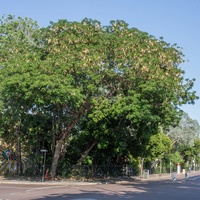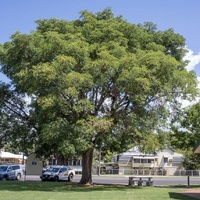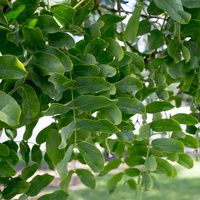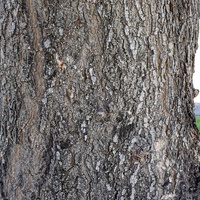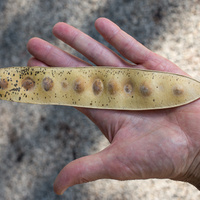Common name: East Indian walnut
Other common names: Broome raintree, Frywood, Koko, Lebbek, Indian sirus, Lebbektree, Rattlepod, Siristree, Woman's tongue, Woman's tongue tree
Description
East Indian Walnut, or Siris, as it's known in India, is a deciduous timber, fodder and landscape tree originating from the Indian subcontinent and Southeast Asia. Its natural range extends from Pakistan through India to Bangladesh and Burma.
In native forests, it may reach up to 30 m (100 ft) tall with a straight trunk and narrow crown. It is typically 10 to 20 m (30 to 60 ft) tall on open sites, with a short trunk supporting a large, rounded, wide-spreading crown. The bark is grey-brown, starts off smooth on young trees, becoming fissured and rough with age.
Leaves are up to 25 cm (10 in) long and twice-feathered, consisting of deep green oblong leaflets arranged in pairs along each leaf branch. They fall from the tree in the dry season, leaving the branches bare until the rainy season, when new leaves emerge and grow to fill out the branches again.
The flowers resemble powder puffs with long greenish filaments and are sweetly fragrant. They bloom when the dry season transitions to the rainy season, coinciding with new leaf growth.
Fertilised flowers develop into flat, papery seedpods that turn light grey-brown when mature and persist on the tree for many months, far into the next dry season.
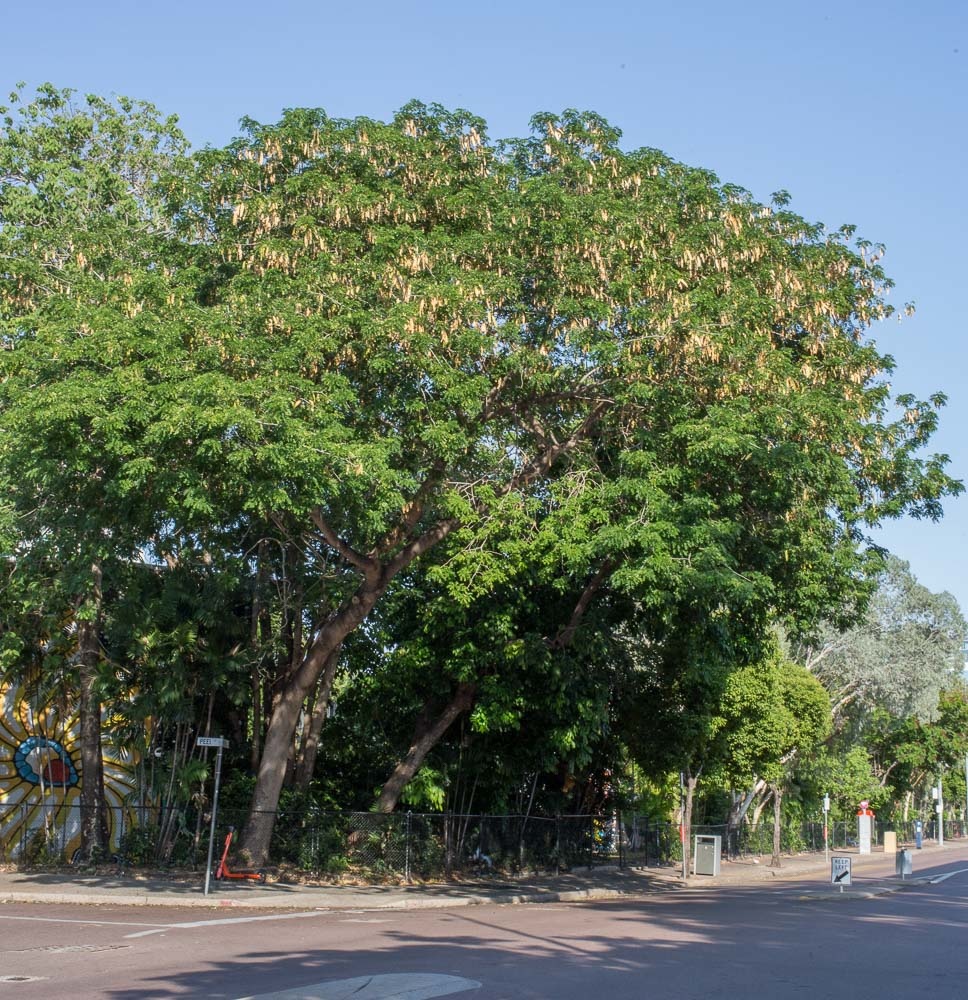
Darwin, Australia
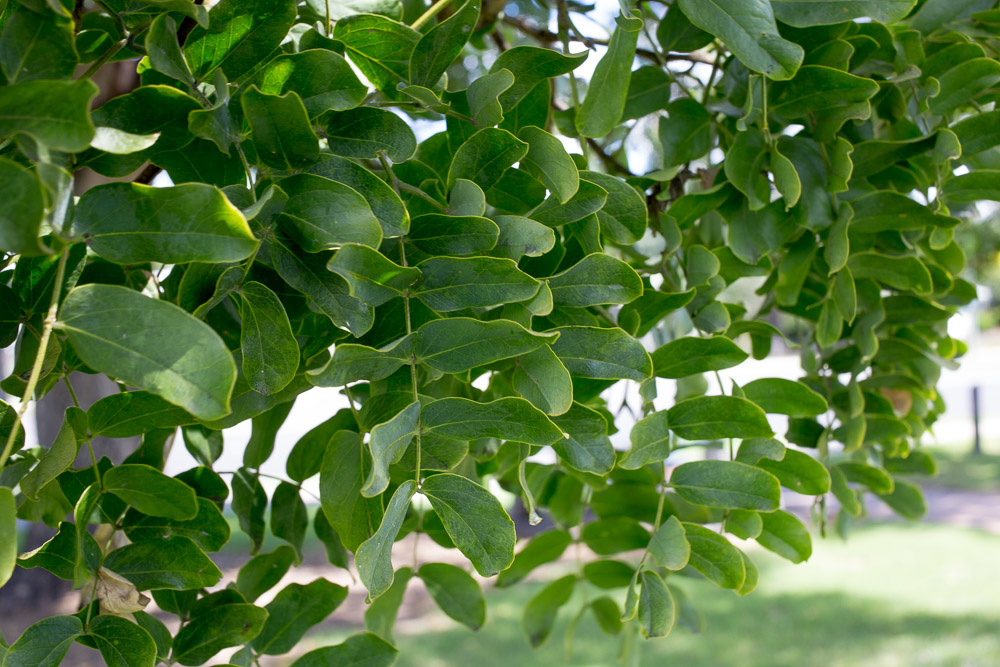
Leaves
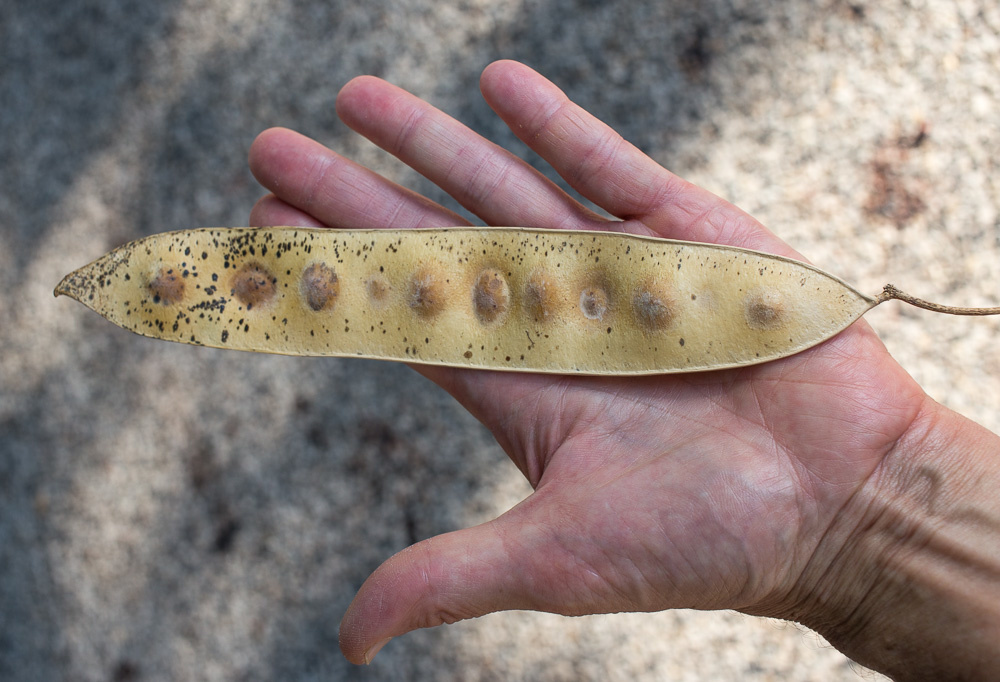
Seedpod
Use
The heartwood is attractive, resembling brown walnut with its characteristic black and grey streaks. However, the weight, durability, and general quality vary considerably among trees with different growth rates. Slow-growing trees generally produce a heavier, more durable, high-quality wood than fast-growing trees.
In the tropics, tree growth rates are strongly influenced by moisture availability, generally increasing with increasing rainfall. As a result, wood density and natural resistance vary considerably, ranging from 500 to 800 kgs per cubic meter (31 to 50 lbs per cubic ft) and non-resistant to moderately resistant.
Well-formed logs are sawn into planks for flooring, furniture, joinery work and cabinets, and selected logs are sliced for decorative veneer. Small diameter lengths and branchwood cut for fuelwood, both firewood and charcoal.
Although rich in nectar, the flower's structure makes it difficult for honeybees to access, which limits its importance as a honey plant.
The fresh leaves and seedpods are used as livestock feed and have a reported crude protein content of about 20% of their dry weight.
It is commonly planted to shade coffee (Coffea arabica) and tea (Camellia sinensis) and for environmental services such as preventing soil erosion, partly because of its nitrogen-fixing abilities and tolerance to adverse growing conditions. It is also sometimes cultivated in gardens and landscapes for the shade it gives and for its showy, fragrant flowers.
Climate
Grows naturally in sub-humid to humid subtropical and tropical climates, generally areas with annual lows of 16 to 25°C, annual highs of 27 to 37°C, annual rainfall of 400 to 2500 mm and a dry season of 2 to 8 months, extending to 12 months with irrigation or groundwater. However, it reaches its best development as a timber tree in areas with annual rainfall of 1300 mm or more.
Growing
New plants are usually started from seed, which are pretreated before sowing by immersing them for a few seconds in boiling water that is then allowed to cool. It performs best on moist to dry, free-draining loam and sand soils of a slightly acid to alkaline nature, generally with a pH of 5.0 to 8.5. It has good tolerance to drought, seasonal flooding, soil salt and limestone soil conditions.
Problem features
The seedpods are produced in large quantities and are easily dispersed by wind and water. It is listed in more than one reference publication as a serious weed and is assessed as a high weed risk for Hawaii and Florida, respectively, by the Hawaii Pacific Weed Risk Assessment project (HPWRA) and by the IFAS Assessment of Non-Native Plants in Florida's Natural Areas. Root-suckering also contributes to its weediness.
Pollen released by the flowers is reported to cause hay fever in some, and the dust from sawn wood irritates the nasal passage.
Where it grows
References
Books
-
Adams, C. D. 1972, Flowering plants of Jamaica, University of the West Indies, Mona, Greater Kingston
-
Allen, O. N. & Allen, E. K. 1981, The Leguminosae : a source book of characteristics, uses, and nodulation, University of Wisconsin Press, Madison, Wisconsin
-
Barwick, M., et al. 2004, Tropical & subtropical trees : a worldwide encyclopaedic guide, Thames and Hudson, London
-
Chevallier, A. 2000, Encyclopedia of herbal medicine, 2nd American ed., Dorling Kindersley, New York
-
Chudnoff, M. 1984, Tropical timbers of the world, Forest Service, U.S. Department of Agriculture (USDA), Washington, D.C.
-
Dey, S.C. 1996, Fragrant flowers for homes and gardens, trade and industry, Abhinav Publications, New Delhi, India
-
Doran, J. C & Turnbull, J. W. 1997, Australian trees and shrubs : species for land rehabilitation and farm planting in the tropics, 2nd ed, Australian Centre for International Agricultural Research (ACIAR), Canberra, Australian Capital Territory
-
Duke, J. A. 1983, Handbook of energy crops (unpublished), Center for New Crops & Plants Products, Purdue University, West Lafayette, Indiana
-
Fawcett, W. 1891, Economic plants, An index to economic products of the vegetable kingdom in Jamaica, Jamaica Government Printing Establishment, Kingston
-
Francis, J. K. 1998, Tree species for planting in forest, rural, and urban areas of Puerto Rico, U.S. Department of Agriculture, Forest Service, International Institute of Tropical Forestry, Río Piedras, Puerto Rico
-
Francis, J. K. and Liogier, H. A. 1991, Naturalized exotic tree species in Puerto Rico, General technical report SO-82, USDA Forest Service, Southern Forest Experiment Station, New Orleans
-
Francis, J. K. et al. 2000, Silvics of Native and Exotic Trees of Puerto Rico and the Caribbean Islands, Technical Report IITF-15, USDA Forest Service, Rio Piedras, Puerto Rico
-
Gohl, B. 1981, Tropical Feeds : feed information summaries and nutritive values (Revised edition), Food and Agriculture Organization of the United Nations (FAO), Rome
-
Hall, N. 1972, The use of trees and shrubs in the dry country of Australia, Australian Government Publishing Service, Canberra, Australian Capital Territory
-
Hocking, D. 1993, Trees for drylands, International Science Publisher, New York
-
Howes, F. N. 1949, Vegetable gums and resins, Chronica Botanica Company, Waltham, Massachusetts
-
Jensen, M. 1999, Trees commonly cultivated in Southeast Asia : an illustrated field guide, 2nd ed., Food and Agricultural Organisation of the United Nations (FAO) Regional Office for Asia and the Pacific (RAP), Bangkok
-
Krishen, P. 2006, Trees of Delhi : a field guide, Dorling Kindersley Publishers, Delhi
-
Letourneux, C. 1957, Tree planting practices in tropical Asia, Food and Agriculture Organization of the United Nations (FAO), Rome
-
Liegel, L. H. 1987. A technical guide for forest nursery management in the Caribbean and Latin America, U.S. Dept. of Agriculture, Forest Service, Southern Forest Experiment Station, New Orleans
-
Luna, R. K 1996, Plantation trees, International Book Distributors, Dehradun, Uttarakhand
-
Macmillan, H. F. 1943, Tropical planting and gardening : with special reference to Ceylon, 5th ed, Macmillan Publishing, London
-
Nair, P. K. R. 1993, An introduction to agroforestry, International Centre for Research in Agroforestry (ICRAF), Kluwer Academic Publishers, Dordrecht
-
National Research Council (Board on Science and Technology for International Development) 1980, Firewood crops : shrub and tree species for energy production (Volume 1), The National Academies Press, Washington D. C.
-
Parrotta, J. A. 2001, Healing plants of peninsular India, CABI Publishing, Wallingford, Oxfordshire
-
Porter, T. 2012, Wood : identification & use, Compact edition, Guild of Master Craftsman Publications, Lewes, East Sussex
-
Randall, R. P. 2002, A global compendium of weeds, R.G. and F.J. Richardson Press, Melbourne
-
Scheffer, T. C & Morrell, J. J. 1998, Natural durability of wood : a worldwide checklist of species, Forest Research Laboratory, Oregon State University, Corvallis, Oregon
-
Schubert, T. H. 1979, Trees for urban use in Puerto Rico and the Virgin Islands. U.S. Department of Agriculture, Forest Service, Southern Forest Experiment Station, New Orleans
-
Singh, R. V. 1982, Fodder trees of India, Oxford & IBH Publishing Company, New Delhi
-
Vázquez, Y. C. 1999, Potentially valuable Mexican trees for ecological restoration and reforestation, Institute of Ecology, Database SNIB-REMIB-CONABIO, Project J084, Mexico
-
Webb, D. B. 1984, A Guide to species selection for tropical and sub-tropical plantations, 2nd ed., Unit of Tropical Silviculture, Commonwealth Forestry Institute, University of Oxford, Oxfordshire
Articles, Journals, Reports and Working Papers
-
Dagar, J. C. & Singh, G. 2007, Biodiversity of Saline and Waterlogged Environments: Documentation, Utilization and Management, NBA Scientific Bulletin, (9), 78.
-
Morton, J. F. 1976, Pestiferous spread of many ornamental and fruit species in south Florida. In Proceedings of the Florida State Horticultural Society (Vol. 89, pp. 348-353).
-
Morton, J.F. 1964, Honeybee Plants of South Florida, Proceedings of the Florida State Horticultural Society, Vol 77:415-436.
-
Nair, P. K. R., Fernandes, E. C. M., & Wambugu, P. N. (1985). Multipurpose leguminous trees and shrubs for agroforestry. Agroforestry systems, 2(3), 145-163.
